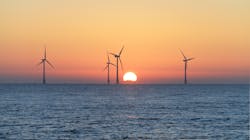Navigating regulatory challenges in Poland's offshore wind sector
Editor's note: This story first appeared in the 2023 Offshore Wind Special Report, which published within the September/October 2023 issue of Offshore magazine.
By Krzysztof Jaworski, Natural Power
As we gaze out on the horizon of Poland's energy industry, the silhouette of offshore wind farms is emerging with promise, charting a new course for the country's renewable energy ambition. Poland has set sail toward a sustainable future, with a national goal to generate 11 GW of power from offshore wind by 2040.
The nation's offshore wind journey, though in its early stages, is being propelled by recent strides forward in granting of permits for offshore wind farm construction and financial support decisions, many more of which are pending.
Poland is drawing insights from the well-trodden path of other countries, primarily in the Baltic and North Sea regions. With the opportunity to apply knowledge and best practice from these well-established nations, Polish companies are staring at a sea of possibilities. Yet, they also face an undercurrent of concerns about the competitiveness of domestic companies in the global market.
According to The Polish Wind Association, offshore wind power capacity is projected to rise to 6.3 GW in 2030, 12 GW in 2040 and 28 GW in 2050. This green expansion offers potential to significantly boost Poland's GDP and create new jobs, with a primary focus on the coast.
The West Pomeranian Region presents an intriguing prospect. Its proximity to Western Europe and Scandinavia's key markets, combined with excellent transport connections and a well-developed port infrastructure, makes it a prime contender for offshore wind development. A constellation of local businesses is already poised to contribute at various stages of development, their experience fortified by longstanding cooperation with the offshore and onshore wind power sectors. However, the lack of local companies specializing in wind farm foundations and operation, service and maintenance of power plants is a critical gap that needs to be bridged. Other regional seaports, while being pillars of the Polish economy, are in need of modernization and expansion to better facilitate offshore wind projects.
Poland's regulatory framework for offshore wind is relatively nascent but evolving rapidly. Passed in 2021, The Offshore Wind Act marked a significant step forward. Whilst it presents challenges, it has been a game changer for the country’s offshore wind sector. Navigating the nation’s regulatory environment requires a deep understanding of both the Offshore Wind Act and the broader legal context (based on civil law), including environmental regulations, maritime laws and grid connection rules. Developers must ensure rigorous compliance with these regulations to avoid legal challenges that could delay or derail projects.
Despite the intricate challenges posed by the regulatory environment, there are substantial opportunities for those who can adeptly navigate these complexities. The Polish government has demonstrated its commitment to the offshore wind sector, not only through its supportive stance but also through tangible financial backing.
The potential of Poland's offshore wind sector is vast, and it is clear that as a nation it stands on the precipice of a transformative era in renewable energy. The country's ambitious renewable energy targets, coupled with the immense potential of the Baltic Sea, present a significant opportunity for growth, but they require a deep understanding of the legal landscape and a meticulous approach to compliance.
With strategic partnerships, innovative solutions and a commitment to harnessing the power of the wind, companies are not just spectators but active participants in this transformative journey. The path is laden with both opportunities and challenges, and with the right approach, Poland's offshore wind sector can become a beacon of sustainable development and a model for other nations to follow.

